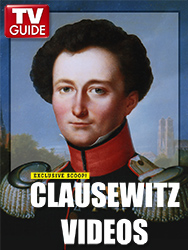
Fifty+ videos making reference to Clausewitz are listed in the 7-page "Clausewitz Videos" section. Some of these have actual educational value—in too many cases, unfortunately, by demonstrating common misunderstandings. Some demonstrate modern scientific or mathematical concepts that many writers consider relevant to Clausewitz's thinking, they may prove enlightening—if you're willing to explore their meaning for the way the physical world actually behaves and to consider their parallels in Clausewitz's world view. Others are merely amusing. They are listed in no particular order of importance.
(THIS PAGE) Relevant Scientific Videos and Discussions — • — |
|
ADDITIONAL PAGES Academic Lectures and Interviews by Prominent Clausewitz Scholars |
|
This is a guide to some pop-culture references to Clausewitz that might be useful bits for lectures or presentations—especially if you are looking to fulfill the U.S. War Colleges' mandatory "Monty Python video requirement" for discussions on strategic theory. |
|
Clausewitz at the Pentagon, 2015 In 2015, then-Under Secretary of Defense for Personnel and Readiness Brad R. Carson invited several prominent Clausewitz scholars to give a series of lectures, which culminated in a panel discussion involving Carsion and six of the series participants. We have 4 full-length classes by individual speakers and the full panel discussion. |
|
Clausewitz's writing were not intended to become doctrine, but they are certainly relevant to doctrine. Explaining the relevance can be done well or poorly. |
LINKS TO RELEVANT SCIENTIFIC VIDEOS AND DISCUSSIONS
Return to Main Videos Page
The primary place to find scientific and mathematical materials relevant to Clausewitz's thinking, including videos, is on the pages described below. There are several videos on the scientific fields of Chaos and Complexity on our page "Illustrations of Chaotic Systems." Clausewitz explicitly used the Randomly Oscillating Magnetic Pendulum ROMP, a classic example of "deterministic chaos," to illustrate his "fascinating trinity." His general framework for understanding the relationship between political and military objectives in war—and the interactions between the various opponents' political and military objectives—has parallels in Edward Lorenz's famous "Strange Attractor." The double pendulum (especially the multiple-instance version) does a lot to explain Clausewitz's obsessions with uncertainty, friction, and the fact that "Everything in war is very simple, but the simplest thing is difficult." His famous comment that "in war more than elsewhere the part and the whole must always be thought of together" is best understood within the context of Complex Adaptive Systems and the concept of "Emergence," which are prominent in Complexity theory. All of this is to say that Alan Beyerchen's argument, in his ground-breaking article "Clausewitz, Nonlinearity and the Unpredictability of War" [International Security, 17:3 (Winter, 1992), pp. 59-90], was fundamentally correct: the reason you don't understand Clausewitz is that you don't understand the modern mathematics and sciences that explain how natural, real-world systems operate.
● See several videos on nonlinearity/Chaos/Complexity science on our "Chaotic System Demonstrators" page. Articles and books discussing these sciences, including some specifically linking them to Clausewitz, can be found at "Clausewitz and Complexity."
● See especially Alan D. Beyerchen [Ohio State University], "Clausewitz, Nonlinearity and the Unpredictability of War," International Security, 17:3 (Winter, 1992), pp. 59-90.
● See also the videos of Professor Beyerchen's presentions and discussion on our "Clausewitz at the Pentagon, 2015" page.
● ROMP: Randomly Oscillating Magnetic Pendulum (See below.) The ROMP is a classic example of deterministic chaos. Clausewitz used this bit of science to illustrate his "fascinating trinity:" "The task, therefore, is to keep our theory [of war] floating among these three tendencies, as among three points of attraction." This is actually a crucially important element to a modern understanding of Clausewitz.
